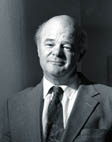 Dear readers, Three momentous events have occurred since my last letter to you. First, we signed a memorandum of understanding between the UC Davis Cancer Center and the Lawrence Livermore National Laboratory to develop an integrated cancer program. This is a fully integrated partnership, as exemplified by recent appointments of Lawrence Livermore National Laboratory scientists to our cancer program. Dennis Matthews is now the associate director for biomedical technology while Jim Felton is associate director for cancer control and Ken Turteltaub is co-leader of the molecular oncology program for the UC Davis Cancer Center. You can read more about projects that are either in progress or pending in this issue. I am confident that we will see extraordinary and exciting results from this union. The extraordinary speed by which the collaboration took place attests to the sincerity of all involved, and our belief that this collaboration will make a difference in the fight against cancer. Second, the UC Davis Cancer Center's Phase II consortium grant, which includes the City of Hope Medical Center and the University of Southern California, was awarded $6.5 million by the National Cancer Institute. This was the largest award given by the National Cancer Institute's Cancer Therapy Evaluation Program (CTEP) this year. David Gandara, our associate director for clinical research, submitted the contract with able assistance from Primo Lara and Paul Gumerlock. We are extremely proud of this achievement. It further demonstrates our dedication to bringing the best and newest treatments to our patients. At the same time, we are working to understand the biology of cancer so that patients in the future will have better and more successful treatments available. Finally, with the help of many and the extraordinary work of a dedicated few, we have submitted our 627-page grant for cancer center designation to NCI. The grant is built around six programs (molecular oncology, cancer biology in animals, therapeutics, cancer control, prostate cancer, and biomedical technology). It also includes six shared resources (molecular pathology, optical biology, mouse biology, pharmacokinetics, biostatistics, and clinical trials). Our cancer center grant reveals a program that is truly integrated. Sixty percent of the grant's members come from the School of Medicine, 20 percent from UC Davis programs such as the School of Veterinary Medicine, the College of Agriculture and Science, the Department of Nutrition and the Division of Biological Sciences, and 20 percent are scientists at Lawrence Livermore National Laboratory. Cancer patients throughout the region will only benefit from having this infrastructure in place. I look forward to telling you more about our progress in future issues of Synthesis. Sincerely,
Ralph
W. deVere White, MD
Home |
Table of Contents |
To our Readers |
Building on Basics UC Davis Health System | © 2000, 2001, 2002 UC Regents. All rights reserved. |
Ralph
deVere White, |


